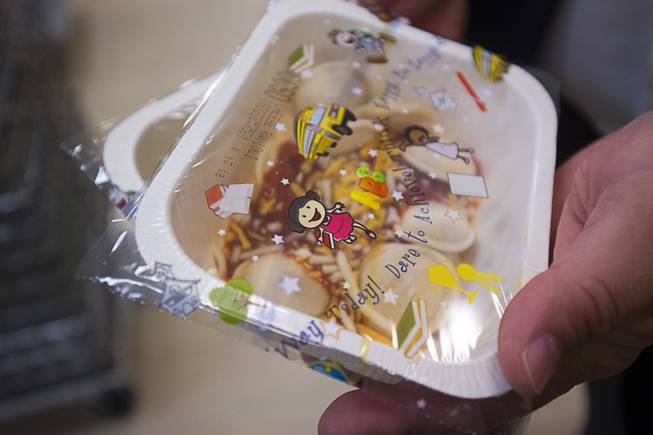
Carlos Morales, director of the Clark County School District Food Service Department, holds a meal at the CCSD Food Service facility Monday, Jan. 25, 2016, near Las Vegas Motor Speedway.
Wednesday, Feb. 3, 2016 | 2 a.m.
Clark County School District dietitians Christina Saheb and Lory Hayon thought they had hit a home run with the debut of shepherd’s pie in school lunches this year.
And then the reviews came in — not from food preparers or school staff, but the kids themselves. The dish was a little bland, they said. The mashed potatoes didn’t have a lot of flavor.
“It was ideal from the inception, but we put it out and we weren’t getting as many positive reviews,” said Carlos Morales, director of CCSD’s Food Services Department.
A couple of years ago, the response from the department would have been along the lines of “too bad,” and thousands of bland shepherd’s pies would have wound up in cafeteria trash cans, wasting thousands of dollars.
But now Morales, who took over the reins last year, says CCSD is taking a different approach.
Hayon sums up that approach like this: “It’s only nutrition if it’s consumed. We want to know before we put it in schools whether or not it’ll be well received and whether we need to do any adjustments.”
And so the women went back to the drawing board at the district’s sprawling, 300,000-square-foot central kitchen on the outskirts of Las Vegas Motor Speedway. It’s where 150 employees work day and night amid the blue-collar cacophony of a dozen stainless steel vats, walk-in fridges and industrial can-openers, handling more than a million pounds of food each day to produce a million school lunches per week.
Saheb and Hayon work just a short walk away from the factory floor in a small office, where the week’s lunch menu is squiggled in black marker on a whiteboard and a refrigerator bears a terse note: “Vendor samples: Please don’t take without permission.”
Among the dietitian's experiments was one involving the mashed potatoes used in the shepherd’s pie. They were made with water, but what if Saheb and Hayon instead mixed them with the nonfat milk already in use?
“We also implemented a different whipping technique that one of our ladies in the central kitchen does,” Saheb said. “It’s just so much creamier.”
They found that the product would still fit within the federal nutrition guidelines school districts are required to follow. A day later, they sent the updated recipe to the factory floor and new shepherd’s pies rolled off the production line into a fleet of trucks that make around 280 deliveries to schools each day.
Then they waited for the reviews. Much better, kids said.
It’s a process of constantly going back to schools to get feedback, re-engineering the food, rinsing and repeating.
“We’ve really been changing the quality of our food,” Saheb said. “We want to make sure everything looks appealing and is just healthier.”
That may seem like a no-brainer, but the world of school lunches has been turned upside down by recent federal restrictions on junk food served in schools. As school meals have toned down on the salt and the sauces, kids’ willingness to eat them has dwindled.
According to Morales, the question has become “can we, as Emeril says, ‘bam’ up the food and still maintain that nutritional guideline?”
“It’s very doable,” he said.
Working within the regulations, the dietitians have been forced to get creative. In past years, the staff didn’t even taste the food. Now, it’s mandatory.
The names of school lunch dishes on the menu now might surprise you. Generic pizzas and chicken sandwiches have given way to baja tacos and spaghetti with beef and marinara.
Currently, the food service bakery only makes cinnamon rolls — featuring different color frosting each month to keep things interesting — though Hayon said they were researching how they could modify machines to help produce savory pies like calzones.
Food services has a lot to work with. Their warehouse, as big as a city block, is chock full of name brand products from Land O’ Lakes shredded cheddar cheese to Dannon yogurt.
Mike Malich, the coordinator who oversees the warehouse and production line, says the facility has enough room to expand to serve another 100,000 kids.
That means many more years of spicy chicken sandwiches, the district’s most popular food in schools by far.
Recently, officials tried to replace the chicken patty used in the sandwich with a different brand. That didn’t go over well, Malich said, and the old patty was put back.
“The kids spoke, and we had to listen,” he said.


Join the Discussion:
Check this out for a full explanation of our conversion to the LiveFyre commenting system and instructions on how to sign up for an account.
Full comments policy